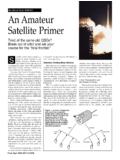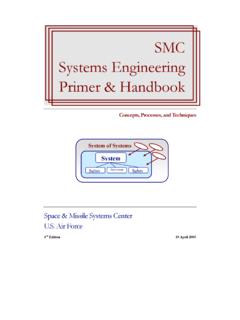Transcription of W.J. Riley Hamilton Technical Services Beaufort, SC 29907
1 Riley Hamilton Technical Services Beaufort, SC 29907 RUBIDIUM FREQUENCY STANDARD primer ii Copyright Notice 2010-2011 Hamilton Technical Services All Rights Reserved No part of this document may be reproduced or retransmitted in any form or by any means, electronically or mechanically, including photocopying or scanning, for any purpose other than the purchaser s personal use, without the express written permission of Hamilton Technical Services . The information in this document is provided without any warranty of any type. Please report any errors or beneficial comments to the address below. Rubidium Frequency Standard primer 10/22/2011 Available from as ID # 9559425 Hamilton Technical Services Phone: 843-525-6495 650 Distant Island Drive Fax: 843-525-0251 Beaufort, SC 29907 -1580 E-Mail: USA Web: Cover photograph: Classic Efratom FRK and modern Symmetricom X72 rubidium frequency standards.
2 FRONT MATTER iii About the Author William J. Riley , Jr. Proprietor Hamilton Technical Services 650 Distant Island Drive Beaufort, SC 29907 Phone: 843-525-6495 Fax: 843-525-0251 E-Mail: Web: Mr. Riley has worked in the area of frequency control his entire professional career. He is currently the Proprietor of Hamilton Technical Services , where he provides software and consulting Services in that field, including the Stable program for the analysis of frequency stability. Bill collaborates with other experts in the time and frequency community to provide an up-to-date and practical tool for frequency stability analysis that has received wide acceptance within that community.
3 From 1999 to 2004, he was Manager of Rubidium Technology at Symmetricom, Inc. (previously Datum), applying his extensive experience with atomic frequency standards to those products within that organization, including the early development of a chip-scale atomic clock (CSAC). From 1980-1998, Mr. Riley was the Engineering Manager of the Rubidium Department at EG&G (later PerkinElmer and now Excelitas), where his major responsibility was to direct the design of rubidium frequency standards, including high-performance rubidium clocks for the GPS navigational satellite program. Other activities there included the development of several tactical military and commercial rubidium frequency standards.
4 As a Principal Engineer at Harris Corporation, RF Communications Division in 1978-1979, he designed communications frequency synthesizers. From 1962-1978, as a Senior Development Engineer at GenRad, Inc. (previously General Radio), Mr. Riley was responsible for the design of electronic instruments, primarily in the area of frequency control. He has a 1962 BSEE degree from Cornell University and a 1966 MSEE degree from Northeastern University. Mr. Riley holds six patents in the area of frequency control, and has published a number of papers and tutorials in that field. He is a Fellow of the IEEE, and a member of Eta Kappa Nu, the IEEE UFFC Society, and served on the Precise Time and Time Interval (PTTI) Advisory Board.
5 He received the 2000 IEEE International Frequency Control Symposium Rabi Award for his work on atomic frequency standards and frequency stability analysis, and the 2011 Distinguished PTTI Service Award recognizing outstanding contributions related to PTTI systems. RUBIDIUM FREQUENCY STANDARD primer iv Dedication This handbook is dedicated to the memory Herbert P. Stratemeyer, my mentor, who introduced me to the time and frequency field and guided my early professional development. Together, we explored the world of rubidium frequency standards. Herbert P. Stratemeyer A Pioneer in Quartz and Atomic Frequency Standards 1931-2001 The frequency control community lost one of its pioneers in the field of quartz oscillators and rubidium atomic clocks when Herbert P.
6 Stratemeyer died on November 20, 2001. Herb was born in 1931 in Mainz, Germany. Although too young to have participated actively in World War II, he nevertheless suffered along with the rest of the civilian population in its later days and aftermath. He received a Diplom Physik degree from the University of Mainz in 1954. During that time, he participated in early single sideband amateur radio experiments with Art Collins and others. Herb began his career in frequency control in the quartz crystal industry in England. In 1954 he immigrated to the United States to accept a position as a Development Engineer at the General Radio Company in Cambridge Massachusetts.
7 At that time, General Radio was the leading manufacturer of electronic instruments. He worked on quartz frequency standards and quartz crystals for filter applications. His first solid-state oscillator, the Model 1115, set new performance standards for low phase noise. Herb Stratemeyer became a citizen in 1962. In the early 1960's, Herb's work turned to atomic clocks, specifically rubidium atomic frequency standards that were just becoming commercially available. Much basic investigation was necessary to develop these devices into practical products, and to devise the processes necessary for manufacturing their lamps and cells. His other contributions included work on frequency synthesizers and quartz crystal measuring systems.
8 The emphasis on rubidium frequency standards at General Radio soon shifted to military and space units. One such device was the NASA Spacecraft Atomic Timing System (SATS), which was the first rubidium clock developed and qualified for space. Another was the physics package for the Collins AFS-81 ruggedized rubidium frequency standard (RFS) used for many years by the Navy in the Verdin VLF communications system. Other projects included RFS designs for missile and tactical aircraft applications. Preliminary work was also done on rubidium clocks for the GPS program. Many of those units had performance equal to or better than most such devices today (although they were much larger and more expensive).
9 In particular, the work at General Radio led to the eventual development of the ultra-stable rubidium clocks used in the Block IIR and IIF GPS satellites. Herb retired from General Radio (then GenRad) in 1975, but continued to consult in the field of atomic clocks at EG&G in the early 1980's. During his retirement, he became a computer "guru" in the 1980's and 1990's. His other interests included gunsmithing, hunting and photography. Herb was an active participant in the frequency control community, regularly attending the Frequency Control Symposium during the Atlantic City era, and contributing to the watershed 1964 IEEE-NASA Symposium on Short-Term Frequency Stability.
10 He was also a loyal IRE/IEEE member. Throughout his career, Herb was a mentor to the next generation of "clock engineers", sharing both his knowledge and work ethic. Herb was an "engineer's engineer", displaying exceptional Technical judgment and keen insight directed toward making things work. He was a man of great intellect with many talents who excelled in whatever he did. He was also a man of great professional and personal integrity who had a positive influence on all the people and programs he worked with. Those of us whose lives he touched will miss him greatly. Note: This biography, written by the author, appears on the UFFC Memoriam web site.







